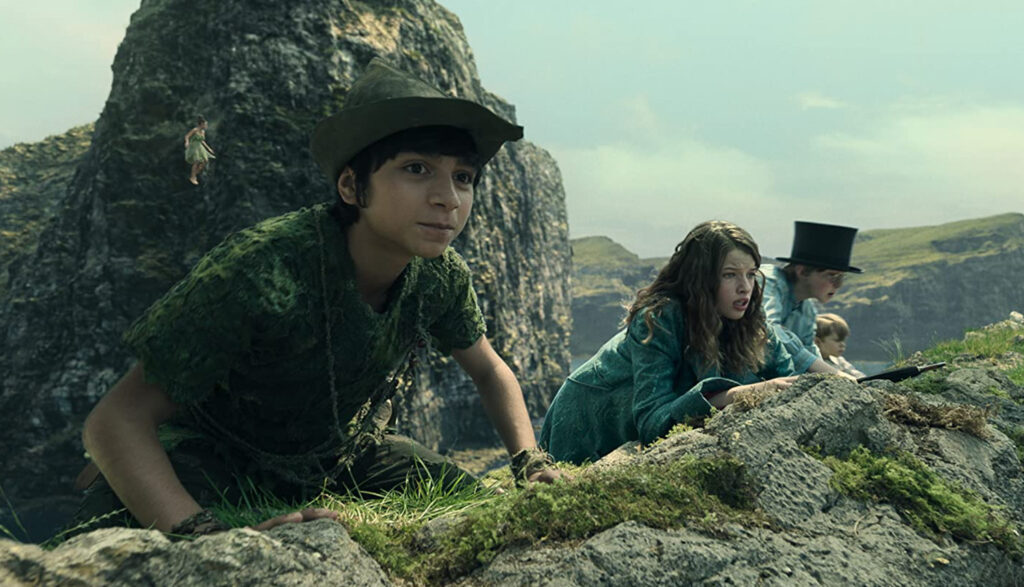
You may be familiar with the story of Peter Pan. Wendy Moira Angela Darling certainly is.
Peter can fly.He lives in Neverland, where there are no rules, no schools, no bedtimes, no mothers, no fathers, and—best of all—no growing up. Peter spends his days fighting the evil pirate, Captain Hook. And he spends his nights playing with the Lost Boys.
At least, that’s what Wendy thought.
After telling her own parents that she doesn’t want to grow up, Peter arrives to whisk Wendy away. But soon after arriving in Neverland, Wendy realizes there’s more to Peter’s story.
For starters, the Lost Boys aren’t all boys. For seconds, Captain Hook wasn’t always captain of the Jolly Roger or a pirate, for that matter. And he certainly wasn’t always evil.
Once upon a time, Hook was a child, just like Wendy, her brothers, the Lost Boys and Peter Pan himself.
Wendy wants the whole story. Because even though Peter’s unwilling to grow up, she’s not entirely sure she is, too.
Wendy is afraid of growing up because she doesn’t believe that adults know how to have fun. She doesn’t want her life to become boring and old. However, her mother encourages her, reassuring Wendy that life’s adventures don’t stop just because you get older. In fact, Wendy’s mother says, you’ll miss out on incredible things because you weren’t there to experience them. And, as she continues, the world will miss out for not having Wendy there.
Tinker Bell, the fairy who accompanies Peter on his adventures, is often misunderstood because her tiny voice can’t be heard. Peter claims he’s the only one who understands her. In reality, Peter only hears what he wants to hear. But Wendy takes the time to get to know Tinker Bell. And eventually, she learns how to listen and understand what Tink is trying to communicate, forging a bond between the two.
Tiger Lily, an Indigenous girl living in Neverland with her tribe, sees Peter as a younger brother in desperate need of guidance. She helps him and the Lost Boys, protecting them, getting them out of sticky situations and even rendering medical aid when Peter gets injured. (She also sets an example for Wendy, who is similarly learning how to be a big sister to her brothers, John and Michael.)
Someone acts sacrificially to save the lives of others. Characters learn how to forgive. A boy learns to take responsibility for his mistakes and tries to make amends. Peter learns that it’s OK to ask for help. Wendy comforts several homesick children by singing a lullaby her own mother used to sing to her and her brothers. A family adopts several children.
Tink, as I mentioned earlier, is a fairy. She uses her powers to move objects around. Her wings allow her to fly. And she generates a magical dust that allows other people to fly as well when they think of happy thoughts.
Peter and several others use this power to fly back and forth between Neverland and London. “Second star to the right and straight on ‘til morning,” Peter says as he and the children soar through the cosmos.
Peter has a mischievous shadow with a mind of its own. It frequently tries to sneak away from Peter and has inaudible conversations with the boy.
Neverland is also home to mermaids, whose glowing (but fully clothed) forms are seen briefly upon Wendy’s arrival with her brothers.
During a fight, Peter cuts off a pirate’s belt, causing the man’s pants to fall. (We don’t see anything since the man is wearing a long shirt, but he quickly covers his privates anyways.) Tinker Bell wears an off-shoulder dress.
When Wendy’s brother tells a hurt Peter that their mother kisses small injuries to help them heal, Peter asks Wendy for a kiss. Instead, she offers him a thimble, telling him it’s a kiss. Later, Peter gives her an acorn (since he believes a kiss is a small token) in return.
Wendy is shocked to learn that not all the Lost Boys are boys. However, when one girl asks her why it matters, Wendy states that “perhaps it doesn’t.”
Peter and Hook are constantly at odds. They exchange death threats and make real attempts on each other’s lives. These exchanges aren’t bloody (though we do see a dark smear on Peter’s chest when Hook manages hit his mark), but they can be frightening.
We don’t see any actual blood on screen, but many characters seemingly fall from great heights to their deaths during battles. Some pirates are killed in a battle with a crocodile. (One poor fellow gets swallowed up by the beast.) The crocodile is stopped when rocks fall on it during a cave-in (though it appears it might still be alive). There are several skeletons chained to an execution rock. Someone is shot through the hand with an arrow. A man grabs a girl by the throat, lifting her off her feet. We hear the story of how Peter cut off Hook’s hand and fed it to the crocodile.
Peter Pan, Tiger Lily, the Darling children and the Lost Boys find themselves in several life-or-death situations. They narrowly escape cannon fire, drowning attempts, an enraged crocodile, swordfights and execution via walking the plank. (Early on, the Darling children play with wooden swords as well.)
Hook threatens many characters, including members of his crew. At one point, he shoots a fellow through a door for mentioning Peter’s name and then tramples over him (though the man seems OK since he continues responding to the captain). Hook smashes a pocket watch.
Many pirates get excited by the thought of killing Peter and the Lost Boys. They sing sea shanties about death. Wendy slaps Peter across the face for saying a dangerous battle was “fun.”
While sewing Peter’s shadow onto his foot, Wendy accidentally pricks him with a needle. Someone shoots a few warning arrows at Wendy. Several pirates incorrectly assume that Michael’s stuffed teddy bear is a real bear that he killed and stuffed for sport.
There is one misuse of the Lord’s name.
Tiger Lily applies herbs to Peter’s wounds to help him heal.
Wendy is a bit rude to her parents because she’s upset that they’re sending her to boarding school. When she gets into trouble for playing with her brothers instead of packing for school, she blames John and Michael. And when John accidentally outs Wendy for breaking a mirror, she’s mean to him in her growing frustration.
Peter is a bit of a narcissist, stating that he likes to hear stories about himself. He’s also a bit of a bully, commanding the Lost Boys to do his bidding. And when some of the children confess to missing their parents, he gets angry.
Characters lie and say hurtful things to each other.
[Note: The rest of this section contains spoilers.] We learn that Peter thinks adults are evil not because of his fear of growing up but rather because of his fear of abandonment. Peter had tried to return to London to his own mother, whom he missed, once before. But it was too late. She had moved from the house he was born in, and Peter never saw her again. So, when he brought other Lost Boys to Neverland, it became a rule that you couldn’t miss your parents.
Hook, who was known as James at the time, broke Peter’s rule. He admitted to missing his mother, so Peter banished him from Neverland. But like Peter, James was unable to find his parents. He was eventually found and raised by pirates instead. And they are the ones who shaped him into becoming the evil Captain Hook we see in this story. Like Peter, Hook’s hatred stems from a fear of abandonment (the one Peter instilled by banishing him).
The story of J.M. Barrie has been told and retold since its original publication in 1904. Some renditions—such as Disney’s original 1953 animated classic—have drawn increasing criticism in recent years for their anachronistic depiction of gender roles, offensive Native American stereotypes and malicious mermaids. (Though the ones in Barrie’s original tale were actually far more monstrous).
Peter Pan & Wendy, Disney’s latest live-action adaptation of its animated classics, seeks to remedy these mistakes of the past. Whether they succeed in this venture is a bit subjective.
The Lost Boys, as I mentioned before, aren’t all boys. (Similarly, the adult pirates aren’t all men either.) And while some may find this inclusion welcome, those familiar with Barrie’s original play and novel may find it more of an insult. In Barrie’s telling, Peter explains that the Lost Boys became lost because they fell out of their prams when their nurses weren’t looking. But girls, said Pan, were much too clever for that.
Take from that what you will, but this slight change does help fix another problem. In Disney’s 1953 film, Wendy is taken by Peter because he wants her to be a “mother” to the Lost Boys: to tell them bedtime stories since that’s all he thinks girls are good for. It led to unnecessary jealousy and rivalries between Wendy, Tiger Lily and Tinker Bell. And considering they were all children, it was pretty silly to say the least.
However, since the Lost Boys portrayed here are chosen for their desire to never grow up, Wendy (as well as the film’s other girls) is no longer constricted to that motherly role by her gender. When she’s asked to tell stories, it’s because Peter thinks she has a genuine talent for it. And instead of becoming damsels in distress, Wendy, Tiger Lily and Tink work together to save Peter and the Lost Boys, proving they can swashbuckle with the best of them.
On another positive note, the film cast a member of the Bigstone Cree Nation to portray Tiger Lily. She even speaks some Cree in the movie. And while this isn’t necessarily original (Universal also cast an Indigenous girl to play the princess in 2003’s Peter Pan), it’s encouraging to see authentic representation in contrast to the harmful stereotypes and racial tropes of yesteryear.
There are also no murderous (or scantily clad) mermaids. However, the crocodile that ate Hook’s hand is still very much present. And much like 1991’s Hook, the reptile is enormous. Moreover, it doesn’t only want Hook (though Hook has a pathological fear of the beast) but rather whatever it can sink its teeth into. And as a result, we see many pirates consumed and killed by the croc.
And unfortunately, the crocodile isn’t the only one trying to commit murder. Hook admits that his hatred for Pan is what fuels him. And his plots to eliminate the “proud and insolent youth” very nearly succeed. But Pan isn’t any better. He despises the “dark and sinister man.” And on his mission to stop Hook once and for all, he and the Lost Boys take out a number of Hook’s pirate cronies.
As a fan of the original Peter Pan, I felt this film held up pretty well. The changes mentioned above help to tell a story that more children can feel a part of. And the music, while not identical, took me back to my childhood in a fun and nostalgic way. Parents should still consider thematic elements and magical content when making a decision about this film. But the film ends on a very positive message: To grow up will be an awfully big adventure.


Emily studied film and writing when she was in college. And when she isn’t being way too competitive while playing board games, she enjoys food, sleep, and geeking out with her husband indulging in their “nerdoms,” which is the collective fan cultures of everything they love, such as Star Wars, Star Trek, Stargate and Lord of the Rings.